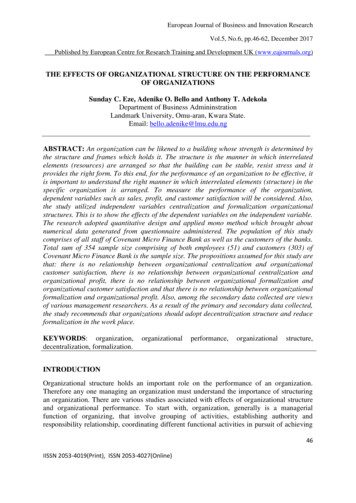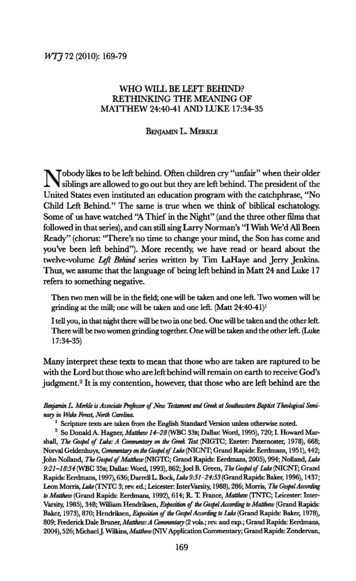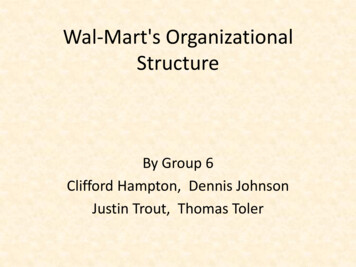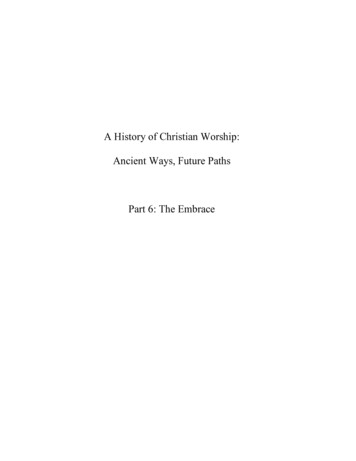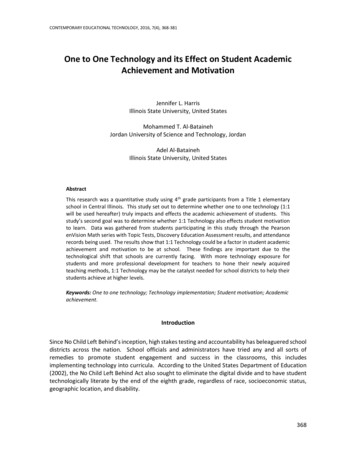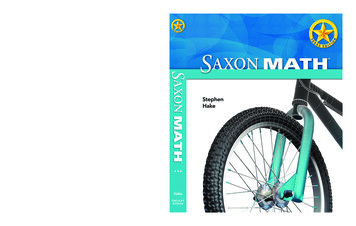
Transcription
There is a structure behindevery high achiever.Saxon Math is structured to help every studentbe a successful mathematics learner. It providesthe time students need to discover, master, andapply mathematical concepts. The structure ofSaxon Math puts students heads above the rest. 0Hake9 781600 325366
Intermediate 3Student EditionStephen Hake
ACKNOWLEDGEMENTSThis book was made possible by the significant contributions ofmany individuals and the dedicated efforts of talented teams atHarcourt Achieve.Special thanks to Chris Braun for conscientious work on Power Upexercises, Problem Solving scripts, and student assessments. Thelong hours and technical assistance of John and James Hake wereinvaluable in meeting publishing deadlines. As always, the patienceand support of Mary is most appreciated.– Stephen HakeStaff CreditsEditorial: Joel Riemer, Hirva Raj, Paula Zamarra, Smith Richardson, Robin Adams,Brooke Butner, James Daniels, Dave Baceski, Cecilia Colome, Pamela Cox, Gayle Lowery,Leslie Bateman, Michael Ota, Stephanie Rieper, Ann Sissac, Chad Barrett, Heather JerntDesign: Alison Klassen, Joan Cunningham, Alan Klemp, Julie Hubbard, Lorelei Supapo,Andy Hendrix, Rhonda HolcombProduction: Mychael Ferris-Pacheco, Jennifer Cohorn, Greg Gaspard, Donna Brawley,John-Paxton GremillionManufacturing: Cathy Voltaggio, Kathleen StewartMarketing: Marilyn Trow, Kimberly SadlerE-Learning: Layne HedrickISBN 13:ISBN 10:978-1-6003-253661-6003-2534-3 2008 Harcourt Achieve Inc. and Stephen HakeAll rights reserved. No part of the material protected by this copyright may be reproduced or utilized in any form orby any means, in whole or in part, without permission in writing from the copyright owner. Requests for permissionshould be mailed to: Paralegal Department, 6277 Sea Harbor Drive, Orlando, FL 32887.Saxon is a trademark of Harcourt Achieve Inc.2 3 4 5 6 7 8 9 048 12 11 10 09 08 07iiSaxon Math Intermediate 3
ABOUT THE AUTHORStephen Hake has authored six books in the Saxon Math series. Hewrites from 17 years of classroom experience as an elementary andsecondary teacher, and as a math specialist in El Monte, California.As a math coach, his students won honors and recognition in local,regional, and statewide competitions.Stephen has been writing math curriculum since 1975 and for Saxonsince 1985. He has also authored several math contests including LosAngeles County’s first Math Field Day contest. Stephen contributed tothe 1999 National Academy of Science publication on the Nature andTeaching of Algebra in the Middle Grades.Stephen is a member of the National Council of Teachers ofMathematics and the California Mathematics Council. He earnedhis BA from United States International University and his MA fromChapman College.iii
CONTENTS OVERVIEWTable of Contents . . . . . . . . . . . . . . . . . . . . . . . . . . . . . . . . . . . . . . . . . vQuick Reference . . . . . . . . . . . . . . . . . . . . . . . . . . . . . . . . . . . . . . . . . xviLetter from the Author . . . . . . . . . . . . . . . . . . . . . . . . . . . . . . . . . . xviiHow to Use Your Textbook . . . . . . . . . . . . . . . . . . . . . . . . . . . . . . . xviiiProblem Solving Overview . . . . . . . . . . . . . . . . . . . . . . . . . . . . . . . . . . 1Section 1 . . . . . . . . . . . . . . . . . . . . . . . . . . . . . . . . . . . . . . . . . . . . . . . . . 7Lessons 1–10, Investigation 1Section 2 . . . . . . . . . . . . . . . . . . . . . . . . . . . . . . . . . . . . . . . . . . . . . . . . 59Lessons 11–20, Investigation 2Section 3 . . . . . . . . . . . . . . . . . . . . . . . . . . . . . . . . . . . . . . . . . . . . . . . 114Lessons 21–30, Investigation 3Section 4 . . . . . . . . . . . . . . . . . . . . . . . . . . . . . . . . . . . . . . . . . . . . . . . 169Lessons 31–40, Investigation 4Section 5 . . . . . . . . . . . . . . . . . . . . . . . . . . . . . . . . . . . . . . . . . . . . . . . 223Lessons 41–50, Investigation 5Section 6 . . . . . . . . . . . . . . . . . . . . . . . . . . . . . . . . . . . . . . . . . . . . . . . 277Lessons 51–60, Investigation 6Section 7 . . . . . . . . . . . . . . . . . . . . . . . . . . . . . . . . . . . . . . . . . . . . . . . 328Lessons 61–70, Investigation 7Section 8 . . . . . . . . . . . . . . . . . . . . . . . . . . . . . . . . . . . . . . . . . . . . . . . 385Lessons 71–80, Investigation 8Section 9 . . . . . . . . . . . . . . . . . . . . . . . . . . . . . . . . . . . . . . . . . . . . . . . 440Lessons 81–90, Investigation 9Section 10 . . . . . . . . . . . . . . . . . . . . . . . . . . . . . . . . . . . . . . . . . . . . . . 494Lessons 91–100, Investigation 10Section 11 . . . . . . . . . . . . . . . . . . . . . . . . . . . . . . . . . . . . . . . . . . . . . . 540Lessons 101–110, Investigation 11English/Spanish Math Glossary . . . . . . . . . . . . . . . . . . . . . . . . . . . 588Index . . . . . . . . . . . . . . . . . . . . . . . . . . . . . . . . . . . . . . . . . . . . . . . . . . 617ivSaxon Math Intermediate 3
TA B LE O F CO N T E N T STA B L E O F C O N T E N T SIntegrated and Distributed Units of InstructionSection 1Lessons 1–10, Investigation 1TEKSPage Strands FocusLessonProblem Solving Overview11 Months and Years CalendarActivity Make a Calendar7A, UP2 Counting PatternsActivity Skip Counting13A, UP3 Reading a Clock to the NearestFive MinutesActivity Set a Clock17M4 Number Line ThermometerActivity Reading and RecordingTemperature21A, G, M, UP5 Fractions of an HourActivity Fractions of an Hour28N, A, M6 Addition33N, UP7 Subtraction38N, UP8 Addition and Subtraction FactFamilies44N9 Unknown Addends48N, UP10 Adding Three Numbers52N, UP Pictographs and Bar GraphsActivity Pictograph and Bar Graph56PSTInvestigation 1TEKS Strands Key:N Number, Operation, and Quantitative ReasoningA Patterns, Relationships, and Algebraic ThinkingG Geometry and Spatial ReasoningM MeasurementPST Probability and StatisticsUP Underlying Processes and Mathematical ToolsTable of Contentsv
TA B L E O F C O N T E N T SSection 2Lessons 11–20, Investigation 2TEKSPage Strands FocusLesson11 Place ValueActivity Place Value59N, UP12 Reading and Writing NumbersThrough 99965N13 Adding Two-Digit NumbersActivity Regrouping69N, UP14 Subtracting Two-Digit NumbersActivity Regrouping for Subtraction75N, UP15 Rounding to the Nearest Tenand Hundred79N16 Adding Three-Digit Numbers85N, UP17 Comparing and Ordering, Part 192N, G, UP18 Some and Some More Stories,Part 197N, UP19 Subtracting Three-Digit Numbers,Part 1102N, UP20 Some Went Away Stories, Part 1108N, UP Working with MoneyActivity Money Exchanges112N, UPInvestigation 2viSaxon Math Intermediate 3
Lessons 21–30, Investigation 3TEKSPage Strands FocusLesson21 Naming Dollars and Cents Exchanging Dollars, Dimes,and PenniesActivity Exchange Pennies for Dimes114N, G, PST22 Adding Dollars and Cents119N, M, UP23 Subtracting Three-Digit Numbers,Part 2124N, UP24 Column Addition130N, UP25 Counting Dollars and CentsActivity Counting Money134N, A26 Subtracting Dollars and Cents140N, G, UP27 Comparing and Ordering, Part 2146N, M, UP28 Subtracting Across ZerosActivity Subtracting Across Zeros152N, UP29 Fractions of a Dollar156N, M30 Estimating Sums and Differences161N More About PictographsActivity Class Pictograph166PSTInvestigation 3TA B LE O F CO N T E N T SSection 3TEKS Strands Key:N Number, Operation, and Quantitative ReasoningA Patterns, Relationships, and Algebraic ThinkingG Geometry and Spatial ReasoningM MeasurementPST Probability and StatisticsUP Underlying Processes and Mathematical ToolsTable of Contentsvii
TA B L E O F C O N T E N T SSection 4Lessons 31–40, Investigation 4TEKSPage Strands FocusLesson31 Writing DirectionsActivity Giving Directions169UP32 Reading and Writing NumbersThrough 999,999Activity Reading and WritingBig Numbers174N, UP33 More About Number LinesActivity Making A Timeline180G, UP34 Length: Inches, Feet, and YardsActivity Inches, Feet, Yards185A, M35 Measuring to the NearestQuarter InchActivity Inch Ruler191G, UP36 Some and Some More Stories,Part 2197N, UP37 Estimating Lengths and DistancesActivity Estimating and MeasuringLengths201M, UP38 Reading a Clock to the NearestMinute206M, UP39 Stories About Comparing211G, UP40 Missing Numbers in Subtraction Some Went Away Stories, Part 2216G, UP Scale MapsActivity Scale Map221M, UPInvestigation 4viiiSaxon Math Intermediate 3
TA B LE O F CO N T E N T SSection 5Lessons 41–50, Investigation 5TEKSPage Strands FocusLesson41 Modeling FractionsActivity Fraction Manipulatives223N42 Drawing Fractions228N43 Comparing Fractions, Part 1Activity Comparing Fractions233N44 Fractions of a Group239N45 Probability, Part 1Activity Probability Demonstration244PST, UP46 Fractions Equal to 1 Mixed Numbers249N47 Equivalent FractionsActivity Equivalent Fractions254N48 Finding Fractions and MixedNumbers on a Number LineActivity Fractions on theNumber Line260N, G49 Comparing Fractions, Part 2265N, UP50 Probability, Part 2270PSTInvestigation 5 Probability Games275PST, UPTEKS Strands Key:N Number, Operation, and Quantitative ReasoningA Patterns, Relationships, and Algebraic ThinkingG Geometry and Spatial ReasoningM MeasurementPST Probability and StatisticsUP Underlying Processes and Mathematical ToolsTable of Contentsix
TA B L E O F C O N T E N T SSection 6Lessons 51–60, Investigation 6TEKSPage Strands FocusLesson51 RectanglesActivity Rectangle List277G, UP52 Length and WidthActivity Measuring Length and Width282G, M53 Rectangular Grid PatternsActivity Rectangular Patterns287A, M54 Multiplication as Repeated Addition292N, A, M55 Multiplication TableActivity Using a Multiplication Table297N, A56 Multiplication Facts: 0s, 1s, and10sActivity Zeros, Ones, and Tens302N, A57 ArraysActivity Arrays306N, A58 Perimeter311M, UP59 Multiplication Facts: 2s and 5s316N, A60 Equal Groups Stories, Part 1321N, UP Bar graphs326PSTInvestigation 6xSaxon Math Intermediate 3
Lessons 61–70, Investigation 7TEKSPage Strands FocusLesson61 Squares Multiplication Facts: SquareNumbersActivity Squares on a Grid328N, A, M62 Area, Part 1Activity Area334N, A, M63 Area, Part 2Activity Estimating Area in SquareFeet340N, M64 Multiplication Facts: 9s345N, A, UP65 AnglesActivity Angles350G, UP66 Parallelograms355G, M, UP67 Polygons361G, M, UP68 Congruent ShapesActivity Congruent Shapes368G, UP69 TrianglesActivity Make Equilateral and RightTriangles373G, UP70 Multiplication Facts: Memory groupActivity Flash Cards378N, A, UP Symmetry, Part 1Activity Symmetry, Part 1383G, UPInvestigation 7TA B LE O F CO N T E N T SSection 7TEKS Strands Key:N Number, Operation, and Quantitative ReasoningA Patterns, Relationships, and Algebraic ThinkingG Geometry and Spatial ReasoningM MeasurementPST Probability and StatisticsUP Underlying Processes and Mathematical ToolsTable of Contentsxi
TA B L E O F C O N T E N T SSection 8Lessons 71–80, Investigation 8TEKSPage Strands FocusLesson71 Rectangular Prisms385G, UP72 Counting CubesActivity Counting Cubes390M, UP73 VolumeActivity Volume394M, UP74 Weight: Ounces, Pounds, and TonsActivity Weighing Objects399M, UP75 Geometric SolidsActivity Solids404G, UP76 Multplication Facts: 11s and 12sActivity Modeling 11s and 12s410N, A, UP77 Multiplying Three NumbersActivity Multiplying to Find Volume416M, UP78 Multiplying Multiples of Ten421N, UP79 Length: Centimeters, Metersand KilometersActivity Metric Units of Length425M, UP80 Mass: Grams and KilogramsActivity Metric Units of Mass431M, UP More About Geometric SolidsActivity Classifying Solids436G, UPInvestigation 8xiiSaxon Math Intermediate 3
Lessons 81–90, Investigation 9TEKSPage Strands FocusLesson81 Multiplying Two-Digit Numbers,Part 1Activity Doubling Money440N, UP82 Fair ShareActivity Fair Share445N, UP83 Finding Half of a Number450N, A, UP84 Multiplying Two-Digit Numbers455N, UP85 Using Manipulatives to Divide by aOne-Digit NumberActivity Equal Groups460N, UP86 Division Facts Multiplication and Division FactFamilies465N, A87 CapacityActivity Measuring Capacity471N, M, UP88 Even and Odd NumbersActivity Even and Odd Numbers476N, UP89 Using a Multiplication Table toDivide481N, UP90 Equal Groups Problems, Part 2486N, UP Symmetry, Part 2Activity Creating Symmetrical Figures491G, UPInvestigation 9TA B LE O F CO N T E N T SSection 9Activity Lines of SymmetryTEKS Strands Key:N Number, Operation, and Quantitative ReasoningA Patterns, Relationships, and Algebraic ThinkingG Geometry and Spatial ReasoningM MeasurementPST Probability and StatisticsUP Underlying Processes and Mathematical ToolsTable of Contentsxiii
TA B L E O F C O N T E N T SSection 10Lessons 91–100, Investigation 10TEKSPage Strands FocusLesson91 Multiplying Three-Digit Numbers,Part 1Activity Estimation by Volume494N, A, UP92 Parentheses Using Compatible Numbers, Part 1499N, A93 Estimating Products504N, A, UP94 Using Compatible Numbers, Part 2508N95 Using Estimation to Verify Answers512N, UP96 Rounding to the Nearest Dollar516N, A, UP97 Multiplying Three-Digit Numbers,Part 2520PST, UP98 Estimating by Weight or MassActivity Estimating by Mass525N, A, M99 Effects of Estimation530N, A100 Multiplying Dollars and Cents534UP Evaluating EstimatesActivity Evaluating Estimates538N, UPInvestigation 10xivSaxon Math Intermediate 3
TA B LE O F CO N T E N T SSection 11Lessons 101–110, Investigation 11TEKSPage Strands FocusLesson101 Dividing Two-Digit Numbers540N, A, UP102 Sorting545UP103 Ordering Numbers Through 9,999549N, UP104 Sorting Geometric Shapes553G, UP105 Diagrams for Sorting559G, UP106 Estimating Area, Part 1564A, M107 Drawing EnlargementsActivity Drawing Enlargements569PST, UP108 Estimating Area, Part 2Activity Estimating Area with a Grid573A, G, M109 Points on a Grid577A110 Dot-to-Dot DesignActivity Dot-to-Dot Design582A, UP586UPInvestigation 11 Planning a DesignTEKS Strands Key:N Number, Operation, and Quantitative ReasoningA Patterns, Relationships, and Algebraic ThinkingG Geometry and Spatial ReasoningM MeasurementPST Probability and StatisticsUP Underlying Processes and Mathematical ToolsTable of Contentsxv
QUICK REFERENCEComparisonSymbolsPlace ValueOnes,Tens,Ones ands,greater thanTime511101210129 less than equal toLength153204871.65212223 CapacityMetricCustomary1 kilometer 1000 meters1 yard 3 feet1 meter 100 centimeters1 foot 12 inchesMass and WeightMetricCustomary1 kilogram 1000 grams1 ton 2000 pounds1 pound 16 ouncesArithmetic with Two dend addend sumgreater lesser differencefactor factor productdividend divisor quotientAnglesaddend addendsumgreater lesserdifferencefactor factorproductAcute angleless than 90ºObtuse anglebetween 90ºand 180ºRight anglequotientdivisor ) dividend90ºLines and SegmentslineAxvisegmentBDESaxon Math Intermediate 3parallel linesperpendicularStraight angle180º
LET TER FROM THE AUTHORDear Student,We study mathematics because it plays a very importantrole in our lives. Our school schedule, our trip to the store,the preparation of our meals, and many of the games weplay involve mathematics. The word problems in this bookare often drawn from everyday experiences.When you become an adult, mathematics will become even moreimportant. In fact, your future may depend on the mathematics you are learningnow. This book will help you to learn mathematics and to learn it well. As youcomplete each lesson, you will see that similar problems are presented again andagain. Solving each problem day after day is the secret to success.Your book includes daily lessons and investigations. Each lesson has three parts.1. The first part is a Power Up that includes practice of basic facts and mentalmath. These exercises improve your speed, accuracy, and ability to do mathin your head. The Power Up also includes a problem-solving exercise to helpyou learn the strategies for solving complicated problems.2. The second part of the lesson is the New Concept. This section introduces a newmathematical concept and presents examples that use the concept. The LessonPractice provides a chance for you to solve problems using the new concept.The problems are lettered a, b, c, and so on.3. The final part of the lesson is the Written Practice. This section reviewspreviously taught concepts and prepares you for concepts that will be taughtin later lessons. Solving these problems will help you practice your skills andremember concepts you have learned.Investigations are variations of the daily lesson. The investigations in this book ofteninvolve activities that fill an entire class period. Investigations contain their own setof questions but do not include Lesson Practice or Written Practice.Remember to solve every problem in each Lesson Practice, Written Practice,and Investigation. Do your best work, and you will experience success and truelearning that will stay with you and serve you well in the future.Temple City, CaliforniaLetter from the Authorxvii
HOW TO USE YOUR TE X TBOOKSaxon Math Intermediate 3 is unlike any math book you have used!It doesn’t have colorful photos to distract you from learning. The Saxonapproach lets you see the beauty and structure within math itself. You willunderstand more mathematics, become more confident in doing math, andwill be well prepared when you take high school math classes.Power Yourself UpStart off each lesson bypracticing your basic skillsand concepts, mental math,and problem solving. Makeyour math brain stronger byexercising it every day. Soonyou’ll know these facts bymemory!LESSON44Texas Essential Knowledge and Skills Fractions of a Group(3.2)(A)(3.2)(C)construct concrete models offractionsuse fraction names and symbols todescribe fractional parts of sets ofobjectsPower UpfactsjumpstartPower Up 44Count down by 6s from 60 to 0.Count down by 9s from 90 to 0.It’s morning. Draw hands on your clock to show 6:39.Write the time in digital form. 6:39 a.m.Draw a 134-inch segment on your worksheet.See student work.mentalmatha. Number Sense: 19 811b. Number Sense: 22 913c. Money: 1.00 0.25 0.75d. Number Line: What number is shown by point B?16Learn Something New!Each day brings you a newconcept, but you’ll only haveto learn a small part of it now.You’ll be building on thisconcept throughout the yearso that you understand andremember it by test time.! problemsolving" # There were 3 boys and 2 girls at the library. Each childchecked out 2 books. Altogether, how many books did thechildren check out? 10 booksNew ConceptWe have used fractions to describe parts of a whole.Sometimes we use fractions to describe parts of a setof items.1 of the letters are vowels:4MATH23 of the marbles are blue:Lesson 44239
You will measure the next two objects or distances in feet.These should be larger objects like the length of a row ofdesks or the distance from your seat to the chalkboard.You will measure the final two objects or distances in yards.These should be several yards such as the length or widthof the classroom.ActivityEstimating and Measuring LengthsMaterials: ruler, yardstickGet Active!Copy the chart below on a piece of paper. With yourpartner, decide on six objects to measure and record themin the first column of the chart.Object to be ardsyardsDig into math with a hands-onactivity. Explore a math concept withyour friends as you work togetherand use manipulatives to see newconnections in mathematics.Before you measure with a ruler or yardstick, estimatethe measure of each object or distance you choose. Weestimate by making a careful guess. You may want to takesmall steps by placing one foot just in front of another tohelp you estimate feet. You can take big steps to help youestimate yards. You should discuss your estimates withyour partner. Write down your estimate before you measurewith a ruler or yardstick.Check It Out!When measuring yards, you can use three rulers insteadof a yardstick. Record the closest whole number of inches,feet, or yards for each object measured.The Lesson Practice lets youcheck to see if you understandtoday’s new concept.Analyze Find 2 items in the classroom that wouldmeasure about 1 foot together. sample: pencil and tape dispenser202Saxon Math Intermediate 3Lesson Practicea. Draw a parallelogram that does not have right angles.See student work.b. What is the perimeter of theparallelogram on the right?Exercise Your Mind!When you work the WrittenPractice exercises, you willreview both today’s new conceptand also math you learned in earlierlessons. Each exercise will be on adifferent concept — you never knowwhat you’re going to get! It’s like amystery game — unpredictableand challenging. IN 14 in. IN c. Multiple Choice Which shapebelow is not a parallelogram? BBCADd. Which shapes in problem c are rectangles?1e. Which angles in this parallelogramare obtuse? angles R and Tf. Which side of this parallelogram isparallel to side QT? side RSWritten Practice1.(60, 24)A, C243Distributed and IntegratedFormulate Gwen has 3 boxes of tiles with 40 tiles in each box.Write a number sentence to show how many tiles are in all3 boxes. 3 40 120 tiles2. Multiple Choice Gwen sees this tile pattern around the edge of(2)a shower. What are the next two tiles in the pattern? AAs you review concepts fromearlier in the book, you’ll be askedto use higher-order thinking skillsto show what you know and whythe math works.ABCD3. Write two addition facts and two subtraction facts using 7, 8,(8)and 15. 7 8 15; 8 7 15; 15 8 7; 15 7 84. Multiple Choice Which shape is not a parallelogram?BCDAB(66)5. One square yard equals 9 square feet. How many square feet is9 square yards? 81 square feet(60, 64)The mixed set of Written Practiceis just like the mixed format of yourstate test. You’ll be practicing forthe “big” test every day!358Saxon Math Intermediate 3How to Use Your Textbookxix
HOW TO USE YOUR TE X TBOOKBecomeInvestigator!Become ananInvestigator!Dive into math conceptsand explore the depthsof math connections inthe Investigations.Continue to develop yourmathematical thinking throughapplications, activities, andextensions.9INVE S TIGATIONFocus onTexas Essential Knowledge and Skills(3.9)(B)create two-dimensional figures with linesof symmetry using concrete models andtechnology(3.9)(C) identify lines of symmetry in twodimensional geometric figures(3.15)(A) record observations using pictures Symmetry, Part 2Recall from Investigation 7 that a line of symmetry divides a figureinto mirror images.Visit www.SaxonMath.com/Int3Activities foran online activity.A figure may have one line of symmetry, two lines of symmetry, ormore. A figure may also have no lines of symmetry.O LINES OFSYMMETRY/NE LINE OFSYMMETRY4WO LINES OFSYMMETRYA line of symmetry also shows where a figure could be foldedin half so that one half exactly fits onto the other half. In thefollowing activity, you will create shapes with one or two linesof symmetry by folding and cutting paper.Activity 1Creating Symmetrical FiguresMaterials: two sheets of paper, scissorsFold a sheet of paper in half. While the paper is folded, cut ashape out of the paper starting from one end of the folded edgeto the other end.Investigation 9491
PROB LE M S OLVI NGOVERVIEWFocus on Problem SolvingTexas Essential Knowledge and Skills(3.14)(B) solve problems that incorporateunderstanding the problem, making a plan,carrying out the plan, and evaluating thesolution for reasonableness.(3.14)(C) develop an appropriate problem-solvingplan or strategy, including acting it out ormaking a table to solve a problem.Problem solving is a part of daily life. We can become powerfulproblem solvers by using the tools we store in our minds. Whenwe study mathematics we increase the number of tools we canuse. In this book we will practice solving problems every day.Four-Step Problem Solving ProcessSolving a problem is like arriving at a new location. So problemsolving is similar to taking a trip.Step123Problem-Solving ProcessUnderstandWe are on the mainland and wantto go to the island.PlanWe can walk or ride our bikeacross the bridge. We can alsouse the boat.Know whereyou are and where you wantto go.Decide how youwill get to the island. This isyour route.SolveCheck4Taking a TripFollow your plan.Be sure thatyou have reached the rightplace.Go to the island.Verify. We are now on the island.Problem Solving Overview1
When we solve a problem, it helps to ask ourselves somequestions along the way.StepFollow the ProcessAsk Yourself Questions1UnderstandWhat do I know?What do I need to find out?2PlanHow can I use what I know?What strategy can I use?3SolveAm I following my plan?Is my math correct?4CheckDid I answer the question that was asked?Is my answer reasonable?The example below shows how we follow the four-step process tosolve a word problem.Example 1Ms. Tipton’s class wanted to pick a color for their classt-shirts. They could choose red, blue, or yellow. Thestudents wrote their votes on slips of paper. Use a tallychart to display the votes. Which color did the LUEYELLOWREDYELLOWREDBLUEREDBLUEYELLOWStep 1: Understand the problem. Votes for three t-shirtcolors are shown on the slips of paper. I need to tally thevotes and find which color was chosen.Step 2: Make a plan. I can make a table to tally the votes.Then I can count the tallies to see which color was chosen.Step 3: Solve the problem. We makeone tally mark in the table for each vote.The color blue has the most votes. So,blue was the color chosen by the class.Our VotesColorredblueyellow2Saxon Math Intermediate 3Tally
Step 4: Check your answer. I can check the tallies in thetable to be sure they match the slips of paper shown. I canverify that the color blue has the most votes.Example 2Four students line up at the water fountain. Eric is behindKatie. Zachary is in front of Katie. Marcela is behind Eric.Who is first in line?Step 1: Understand the problem. I know the following: There are four students. Eric is behind Katie. Zachary is in front of Katie. Marcela is behind Eric.I need to find who is first in line.Step 2: Make a plan. I can act out this problem. I can make anametag for each student—Eric, Katie, Zachary, and Marcela.Then I can use what I know to put the nametags in the correctorder.Step 3: Solve the problem.I put the nametags in orderstarting with Eric and Katie.Since Eric is behind Katie,I place Katie in front of Eric. ATIE%RICZachary is in front of Katie. So, I move him to the front.:ACHARY ATIE%RICMarcela is behind Eric. So, I move her to the very back.:ACHARY ATIE%RIC-ARCELAThe order is Zachary, Katie, Eric, Marcela. I can look at the lineof nametags and see that Zachary is first.Step 4: Check your answer. I can check the order of thenametags by reading the question again. There are four students. Eric is behind Katie.Problem Solving Overview3
Zachary is in front of Katie. Marcela is behind Eric.The order is correct. I answered the question asked. Zacharyis first in line.1. List the four steps in the problem solving process.1. Understand, 2. Plan, 3. Solve, 4. Check2. What two questions do we answer to understand theproblem? What do I know? What do I need to find out?Refer to the following problem to answer problems 3–8.Denzel arranges his rock collection into 5 rows. Each row hasone more rock than the row above it. The bottom row has6 rocks. How many rocks are in Denzel’s collection?3. What do we know?4. What do we need to find?the number of rocks in Denzel’s collection5.Which step of the four-step process did youcomplete in problems 3 and 4? Step 1: UnderstandConnect6. Describe your plan for solving the problem.3. Denzel has fiverows of rocks.Each row has onemore rock thanthe row above it.The bottom rowhas six rocks.6. sample: I can act outthe problem using colortiles. I can start with thebottom row of 6 rocks.This is Row 5. Then I canwork backwards to find thenumber of rocks in rows 4,3, 2, and 1.7. Solve the problem by following your plan.There are 20 rocks in Denzel’s collection.8.ExplainCheck your answer.8. sample: I made five rows. I count the number oftiles in each row: 2, 3, 4, 5, 6. The bottom row has sixtiles. Each row has one more tile that the row above it.I count a total of 20 tiles. I used the information in theproblem. I counted correctly, so my answer is correct.Problem-Solving StrategiesProblem-solving strategies are types of plans we can use tosolve problems. In example 1 we made a table and in example 2we acted out the problem. The list below shows the problemsolving strategies that we will use in this book.Draw a Picture. We can use the information in a problem to drawa picture of the problem. Then we can use our picture to help usfind the solution.Look for a Pattern. Sometimes the order of a list of numbersor shapes follows a pattern. If we study the list we can find thepattern. Then we can predict what number or shape will comenext.Make a Table. We can organize what we know in a table. Thenwe study the table to see a pattern or relationship that will help ussolve the problem.4Saxon Math Intermediate 3
Guess and Check. We can guess a reasonable answer and thencheck to see if our guess is correct. If the guess is not correct, weuse the information we learned from the guess to make a betterguess. We continue to guess until we find the correct answer.Act It Out. We can use objects or people to represent the actionsin a problem.Work a Simpler Problem. Some problems contain largenumbers. Sometimes we can use smaller numbers to see how towork the problem. Then we use the same plan to solve the harderproblem.Work Backwards.
978-1-6003-2536-6 1-6003-2536-X 9781600325366 00000 There is a structure behind every high achiever. Saxon Math is structured to help every student be a successful mathematics learner. It provides the time students need to discover, master, and apply mathematical concepts. The structure of Sax

